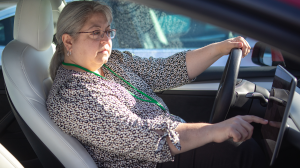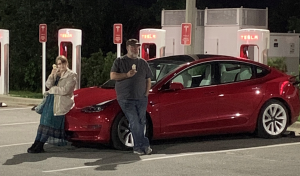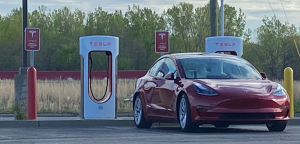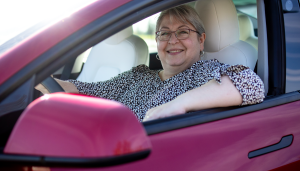‘Let’s Take It,’ Part II
(This is the second of a two-part series about Power Moves team member Laura Matney’s road trip to Florida. You can read Part I here.)
Family charges to Florida and back on memorable electric vehicle voyage
Traveling electric vehicle owner Laura Matney giggled while glancing at goods when visiting an unexpected location: a gas station convenience store.

Laura Matney selects an option on the Tesla Model 3 navigation. The vehicle’s navigation displays Tesla Supercharger locations and anticipated range available to reach the destination, as well as real-time traffic conditions and estimated travel time.
Matney, the marketing manager for Wabash Valley Power Alliance and member of the Power Moves® team, traveled from her Columbus, Indiana, home to Sarasota, Florida, in the family’s electric Tesla Model 3. After purchasing the vehicle earlier this year, it wasn’t long before she wanted to take it for the long-distance Florida trip she had already scheduled with her husband and daughter. That meant planning for stops to charge the vehicle; one stop included a Tesla Supercharger near a Florida gas station.
“The convenience store was fun. They had a lot of snacks and things that we hadn’t seen before, so we were literally being tourists in a convenience store,” Matney said. “I’m sure people thought we were nuts.”

Laura Matney’s daughter and husband enjoy ice cream during a break to let the Tesla Model 3 charge. The family stopped at Tesla Superchargers located near destinations such as restaurants or stores where they could also get food and walk around.
The family organized the more than 2,100-mile trip well in advance, plotting travel based on the location of Tesla Superchargers. The family’s first travel day was the “most aggressive,” Matney said, departing at 7 a.m. and, with stops for charging and walking around, exhaustingly reached their Tallahassee, Florida, hotel at 10:30 p.m.
“For people who like to get in the car and just drive and drive nonstop to get to Florida, I don’t think an EV is going to work very well for them,” Matney said. “With our car, we stopped every two hours for maybe 30 minutes. In some cases, it was a little bit less, in some cases it was a little bit more.”

The Matneys’ Tesla Model 3 charging at a Tesla Supercharger in Kentucky. They saved money on taking the Tesla on the trip to Florida compared to their gas-powered vehicle, though public chargers cost the Matneys significantly more money than charging the Tesla 3 at home.
Matney was worried that a traffic jam or broken charger could lead to issues recharging the vehicle, particularly in rural areas where Tesla Superchargers were far apart. In some locations, there were no alternative electric vehicle chargers. Yet ultimately travel “was very smooth,” Matney said, with the Tesla Supercharger network not having any issues.
“My husband commented that he really liked knowing where our next stop was going to be and to be able to rest and stretch his legs a little bit,” she said of the Tesla’s navigation system which updates drivers with location and traffic details. “You didn’t just feel like you were hurtling down the highway. It was nice to take a few breaks.”
The second day of travel from Tallahassee to Sarasota was much shorter; the family had breakfast before leaving the hotel, and ultimately reached the condo where they were staying by 4 p.m. The Matneys’ most challenging charger experience took place in Birmingham, Alabama; a Tesla Supercharger was located in a parking lot that required payment to enter, and the charger powered the vehicle more slowly than other stops. The family took an alternate route returning to Indiana.

Laura Matney sits in her family’s Tesla Model 3. After purchasing the vehicle earlier this year, Matney and her family took it on a road trip from Columbus, Indiana, to Sarasota, Florida.
The Matneys’ Tesla Model 3 features an estimated range of 263 miles per charge, according to the Kelley Blue Book website. The family spent $212 on charging the vehicle during the trip. The Matneys’ other vehicle, a 2015 Ford Fusion that gets about 27 miles per gallon of gasoline, would have cost $287 to take on the trip.
The public chargers were more expensive than the Matneys’ cost to charge their Tesla 3 at home, which would have cost $87.53.
“It’s not as much savings as what some people may think. If you charge at home for 15 cents or less per kilowatt-hour, it makes a whole lot of sense,” Matney said of the cost savings for an electric vehicle. “But when you are using public chargers, they do cost more.”
Matney would like to see more EV chargers have rooftop covers and more lighting, similar to gas stations, for protection from wind and rain. Many of them were simply “tucked in a parking lot somewhere” and exposed to the elements.
The family enjoyed the experience and is already planning more road trips. Matney and her husband will drive to northern Georgia later this summer, and she’s planning a trip with one of her friends to Minnesota in late July. She already has started plotting the journey based on the location of Tesla Superchargers and a preference to avoid traveling through Chicago traffic.
“This trip was what we were expecting,” Matney said of the Tesla’s inaugural road trip. “The traffic was smooth. The charging equipment all worked. The onboard navigation on the car was great, and we really didn’t have any surprises.”